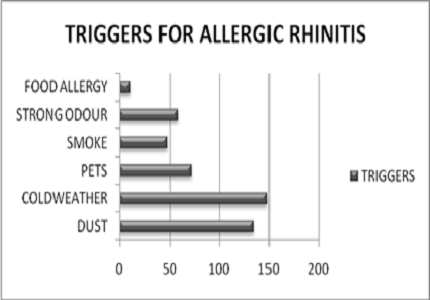Correlation between sfar score and nasal cytology in paediatric allergic rhinitis patients visiting OPD in Goa Medical College
Abstract
Background: The prevalence of allergic rhinitis is 10-20% worldwide. Allergic rhinitis being a non fatal condition is often trivialized but it causes significant morbidity. The diagnosis of allergic rhinitis is mainly clinical, which often fails in differentiating allergic versus non allergic rhinitis. The importance of this study is to find the effectiveness of nasal mucosal cytology as a diagnostic method for allergic rhinitis, nasal cytology being a simple, non invasive and easily available test may be used as a tool in the diagnosis of allergic rhinitis.
Objective: To find the correlation between SFAR score and nasal mucosal eosinophilia in diagnosing allergic rhinitis.
Materials and Methods: This was a descriptive prospective hospital based study conducted over a period of two years in Goa medical college. Children in the age group of 1-12 years in whom a clinical diagnosis of allergic rhinitis was made based on ARIA guidelines were included in the study. A subjective definition of allergic rhinitis was made using SFAR score. Nasal smears were collected and examined for eosinophils. A semi quantitative scale was used for grading nasal mucosal eosinophilia.
Results: A positive correlation was obtained between nasal smear eosinophilia and SFAR score. The spearman’s correlation was 0.426 suggesting a correlation.
Conclusion: Nasal mucosal smear eosinophilia can be used as a simple, cheap and non invasive method in diagnosing allergic rhinitis especially in resource limited settings.
Downloads
References
2. Bousquet J, Neukirch F, Bousquet PJ et al. Severity and impairment of allergic rhinitis in patients consulting in primarycare. J Allergy Clin Immunol. 2006 Jan;117(1):158-62. Epub 2005 Dec 2. DOI: 10.1016/j.jaci.2005.09.047. [PubMed]
3. Green RJ, Davis G, Price D. Concerns of patients with allergic rhinitis: the AllergicRhinitis Care Programme in South Africa. Prim Care Respir J. 2007 Oct;16(5):299-303. DOI: 10.3132/pcrj.2007.00062. [PubMed]
4. Léger D, Annesi-Maesano I, Carat F, Rugina M et al. Allergic rhinitis and its consequences on quality of sleep: an unexplored area. Arch Intern Med. 2006 Sep 18;166(16):1744-8. DOI: 10.1001/archinte.166.16.1744. [PubMed]
5. Lucente FE. Rhinitis and nasal obstruction. Otolaryngol Clin North Am. 1989 Apr;22(2):307-18. [PubMed]
6. Kurukulaaratchy RJ, Matthews S, Arshad SH. Defining childhood atopic phenotypesto investigate the association of atopic sensitization with allergic disease. Allergy. 2005 Oct;60(10):1280-6. DOI: 10.1111/j.1398-9995.2005.00890.x.
7. G.Roberts, M.Xatzipsalti, L.M.Borrego, A.Custovic, S.Halken, P.W.Hellings, N.GPapadopoulos, G.Rotiroti, G. Scadding, F.Timmermans & E.Valovirta. Paediatric rhinitis: position paper of the European Academy of Allergy and Clinical Immunology. European Journal of Allergy and Clinical Immunology. July 2003.
8. Rondón C, Romero JJ, López S et al. Local IgE production and positive nasal provocation test in patients with persistent nonallergic rhinitis. J Allergy Clin Immunol. 2007 Apr;119(4):899-905. Epub 2007 Mar 2. D OI: 10.1016/j.jaci.2007.01.006. [PubMed]
9. Romero JN, Scadding G. Eosinophilia in nasal secretions compared to skin prick test and nasal challenge test in the diagnosis of nasal allergy. Rhinology. 1992 Sep;30(3):169-75. [PubMed]
10. Brozek JL, Bousquet J, Baena-Cagnani CE et al. Allergic Rhinitis and its Impact on Asthma (ARIA) guidelines: 2010 revision. J Allergy Clin Immunol. 2010 Sep;126(3):466-76. doi: 10.1016/j.jaci.2010.06.047. [PubMed]
11. Annesi-Maesano I, Didier A, Klossek M, Chanal I et al. The score for allergic rhinitis (SFAR): a simple and valid assessment method in population studies. Allergy. 2002 Feb;57(2):107-14.
12. Sood A. Diagnostic significance of nasal eosinophilia in allergic rhinitis. Indian J Otolaryngol Head Neck Surg. 2005 Jan;57(1):13-6. doi: 10.1007/BF02907618. [PubMed]
13. Rakesh Chanda, Ajay Kumar Aggarwal, G.S. Kohli, T.S. Jaswal, K.B. Gupta. Compatitive study of nasal smear and biopsy in patients with allergic rhinitis. Indian J Allergy Asthma Immunol 2002; 16(1) : 27-31.
14. Shioda H, Mishima T. Significance of mast cells in nasal smears from patients with food allergy. J Allergy. 1966 Jun;37(6):321-8. [PubMed]
15. AD Olusesi, MA Said, EJ Amodu.A correlation of symptomatology with nasal smear eosinophilia in non infectious chronic rhinitis preliminary report. Nigerian Journal of Clinical Practice ,September 2007 vol 10(3): 238-4.
16. Naveen Kumar, Kiran Bylappa, Ramesh AC, Swetha Reddy.A study of eosinophil count in nasal and blood smear in allergic respiratory diseases in a rural setup.Internet Journal of Medical Update 2012 January ,7(1):40-6. [PubMed]
17. Ologe FE,Adebola SO,Dunmade AD, Adenji KA,Oyejola BA. Symptom score for allergic rhinitis. Otolaryngol Head Neck Surg.2013 Apr,148(4):557-63. [PubMed]

Copyright (c) 2016 Author (s). Published by Siddharth Health Research and Social Welfare Society

This work is licensed under a Creative Commons Attribution 4.0 International License.


 OAI - Open Archives Initiative
OAI - Open Archives Initiative


